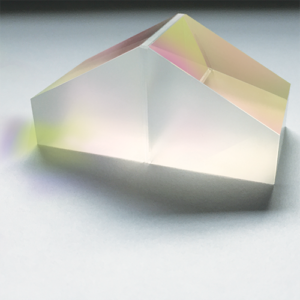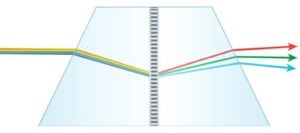What is a Grism?
A grism is a compound optical element made from GRating and prISM(s) – hence its name Grism. It is a dispersive element that cleverly exploits the differences between gratings and prisms, thereby permitting an in-line optical layout. The diffraction grating deflects red more than violet, while the prism deflects violet light more than red. When combined, it is possible to separate light into its component parts while offsetting the beam deviations caused by each element. Light is dispersed, but the influence on the overall direction of beam travel is significantly reduced, limiting any impact on your system’s optics.

Image Credit: Wasatch Photonics, Inc.
As detailed in this article, Wasatch Photonics has designed and manufactured VPH grating-based grisms to serve a wide range of research needs. Based on the given application, it is possible to select and control the groove density and prism(s) used to generate the required dispersion and output angle(s) for particular wavelength(s) of interest.
Grisms: Tips & Tricks for the Optical Designer’s Toolbox
#1) Achieve Dispersion without Beam Deviation
When a grism is designed, one or two prisms may be included so that light at a specific central wavelength passes straight through. This feature can transform a camera into an imaging spectrograph and is commonly applied in astronomical telescopes to create high-resolution, spectrally selective images. It may also be incorporated into a conventional spectrometer layout to prevent beam turning or spectrally encoded confocal microscopy (SECM). These examples typically employ a prism on both the input and output surfaces to ensure alignment is maintained to an optical axis while allowing dispersion from the grating for spectral selection or imaging.

Image Credit: Wasatch Photonics, Inc.
#2) Get the Exact Geometry Required
A grism allows the optical designer to have increased control over the input and output geometries of the dispersive optical element in an imaging system. This means that geometric leveraging can be combined with Wasatch’s ability to manufacture non-Littrow or non-symmetric gratings or prism configurations that have enough variances in angle from input to output, thereby preventing ghosting.
#3) Increase Grating Design Options
In some applications where VPH gratings are used, the required high line frequency or center wavelength limits the capacity for light to pass into or out of a plano grating element, as a result of total internal reflection (TIR). Incorporating a prism can enhance the ability of light to enter or exit the grating volume, revealing more design options.
#4) Optimize Your Grating Efficiency
In some applications, VPH gratings demand high dispersion. Still, it is possible to take advantage of “in-glass” design criteria to optimize efficiency for either unpolarized light or a single polarization of light.
#5) Correct for Aberrations
A prism with a grating can be used to correct for the ‘smile’ observed in certain hyperspectral imaging designs, improving both resolution and throughput.

This information has been sourced, reviewed and adapted from materials provided by Wasatch Photonics, Inc.
For more information on this source, please visit Wasatch Photonics, Inc.